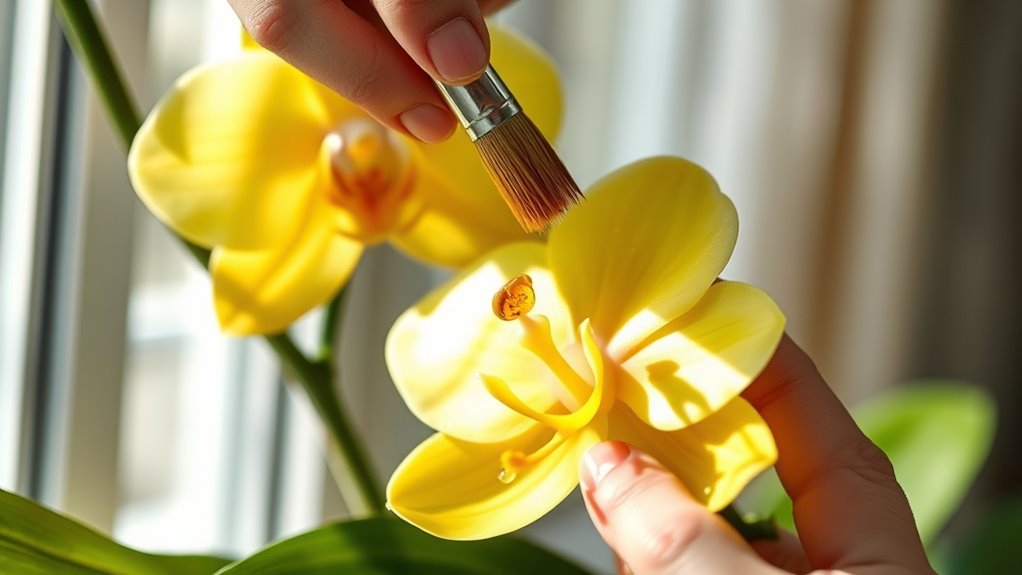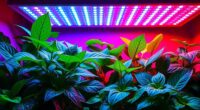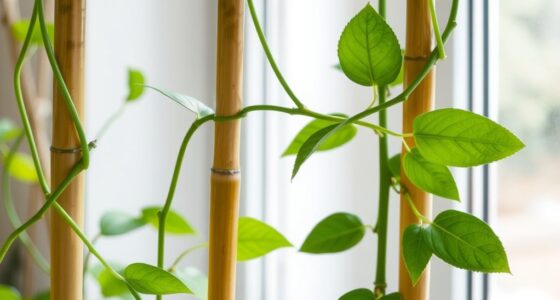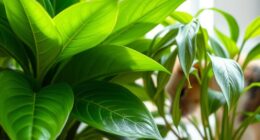To pollinate indoor plants, especially fruiting types like tomatoes and cucumbers, gently transfer pollen using a soft brush or cotton swab. Shake self-pollinating plants to aid circulation or use fans to mimic natural conditions. You’ll want to watch for fully open flowers and changes in pollen color to know when to pollinate. Maintaining humidity and optimal temperatures boosts success. Want to enhance your indoor gardening skills even further? There’s more to explore!
Key Takeaways
- Use a soft brush or cotton swab to gently transfer pollen from the anther to the stigma of flowers.
- Shake self-pollinating plants like tomatoes to help release pollen for better fruit production.
- Ensure proper air circulation with fans to aid in pollen distribution and prevent stagnant air.
- Monitor humidity and temperature to maintain optimal conditions for effective pollination and plant health.
- Regularly check for flower readiness and pollination needs, especially for cross-pollinating plants like cucumbers and squash.
Importance of Pollination for Indoor Plants
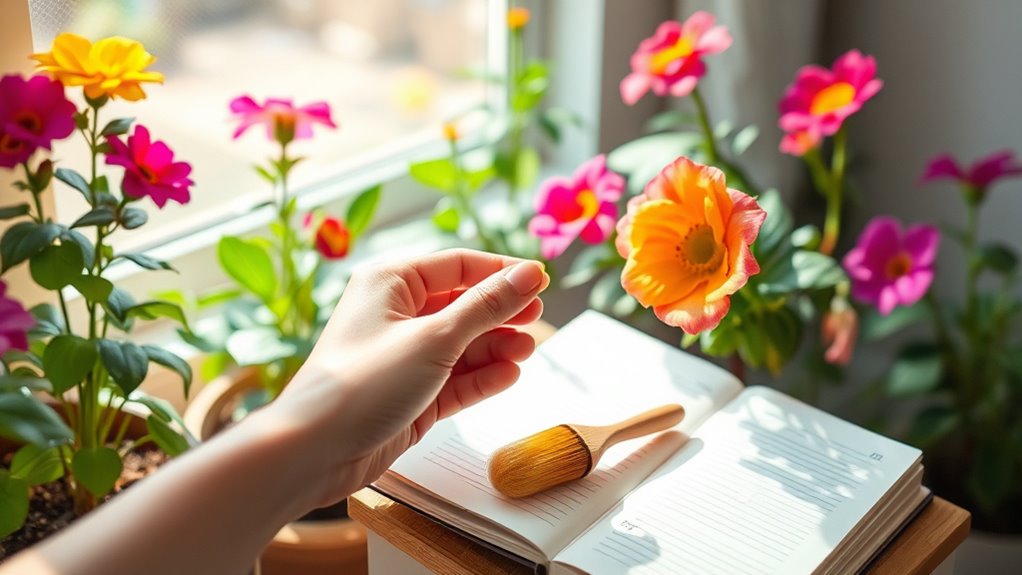
While you may not realize it, pollination plays a vital role in the success of your indoor plants. It’s especially important for fruiting plants like tomatoes and cucumbers, as pollination is essential for them to produce fruit indoors. Without it, you mightn’t yield the fruits or seeds you desire.
By ensuring proper pollination, you enhance not only the quantity but also the size and quality of your produce. Additionally, pollination helps maintain the health of your plants by supporting their reproductive cycle. Indoor gardeners often lack natural pollinators like bees, making manual techniques even more important. Understanding the importance of planning for your indoor garden can also lead to better outcomes. Choosing diverse camping locations can inspire creativity in your gardening approach. Incorporating gentle methods can also help create a nurturing environment for your plants.
For indoor gardeners, manual pollination techniques are crucial due to the absence of natural pollinators, maximizing crop yield and promoting genetic diversity among your indoor plants. Embracing these practices can lead to a thriving indoor garden.
Understanding the Pollination Process
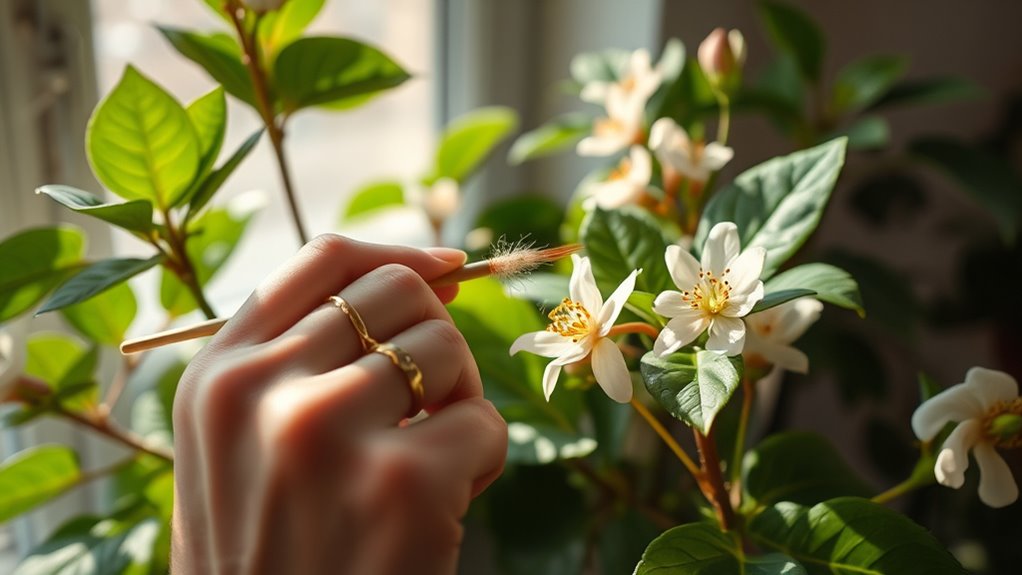
Pollination is a fascinating process that directly impacts the success of your indoor plants. It involves transferring pollen from the male part of the flower, called the anther, to the female part, known as the stigma. This essential step facilitates fertilization and seed production. While outdoor plants often rely on bees and wind, your indoor plants may need a bit of help. Some plants, like peppers and tomatoes, can self-pollinate but still benefit from your assistance to boost yield. Regular pollination, ideally once a week, ensures continued flower development. Self-pollinating plants may still struggle to set fruit under indoor conditions, making your involvement even more important. Additionally, providing proper care such as adequate light and moisture levels can further enhance the pollination process. Understanding how high refresh rates can improve the responsiveness of pollination techniques, such as using gentle shaking, can also help you make informed decisions about your investment in these plants. So, whether you’re using a brush, gentle shaking, or fans for air circulation, understanding this process is key to thriving indoor plants.
Types of Indoor Plants That Require Pollination

If you want to enjoy a fruitful indoor garden, it’s essential to know which plants require pollination.
Apples and pears need cross-pollination for fruit production, while plums also benefit from it for better yields. Beekeepers play a crucial role in ensuring effective pollination in larger gardens. To enhance pollination, consider choosing the right pollinator to match your specific plants’ needs. Utilizing high-quality equipment can also improve the overall health of your plants, leading to better fruit production.
Berries may need assistance, and although peaches are self-pollinating, they can thrive with extra help. Self-pollinating plants like tomatoes typically do not require external assistance for pollen transfer, making them easier to care for indoors.
For vegetables, cucumbers, squash, and gourds require cross-pollination, while peppers and eggplants can benefit from additional support despite being self-pollinating. Tomatoes are self-pollinating but respond well to gentle vibrations.
Citrus trees, like lemon and pomegranate, are mostly self-pollinating but appreciate gentle shaking. Lastly, crops like watermelon and corn need cross-pollination for optimal growth.
Knowing these plants will help you create a bountiful indoor garden.
Methods for Hand Pollination

Understanding which indoor plants need pollination sets the stage for successfully helping them bear fruit. You can employ various hand pollination methods to achieve this.
The brush method uses a soft-bristled brush or cotton swab to transfer pollen from the anther to the stigma. For self-pollinating plants like tomatoes, gently shaking the plant works well. Additionally, using a fan can help circulate air and aid in pollen distribution. Alternatively, you can use a fan to circulate air and aid in pollen distribution. Montessori toys can inspire creativity in children, making them great for learning about plant life cycles. It’s important to note that plant health can significantly affect the success of pollination, as maintaining nutrient balance is crucial for optimal flowering.
The brush method and gentle shaking are effective techniques for aiding pollination in indoor plants like tomatoes.
Directly transferring pollen from a male flower to a female flower is effective for cucumbers and zucchinis. Additionally, vibrating tools like an old toothbrush can stimulate pollen release.
Choose the method that best suits your plants, and repeat the process to increase your chances of success.
Tools You Need for Effective Pollination

To successfully pollinate indoor plants, you’ll need a few essential tools that can make the process easier and more effective.
Start with small brushes or clean cotton swabs for manually transferring pollen. An electric toothbrush can help create vibrations that mimic bees, while specialized tools like the Be-the-Bee Pollinator enhance pollen transfer. It’s important to note that natural pollination methods can be challenging to replicate indoors, making these tools particularly beneficial. Additionally, using motor skills to handle these tools effectively will improve your pollination success rate. Incorporating scratching posts for your indoor plants can also help in maintaining their overall health and viability. Leveraging data analytics can also help you understand which plants need pollination at specific times for optimal growth.
Don’t forget oscillating fans to distribute pollen evenly throughout your space. If you’re looking for household alternatives, repurpose small paintbrushes or even eyeliner brushes; they work well for precise applications.
Wearing gloves is optional but can help prevent transferring oils from your hands. With these tools at your disposal, you’ll be well-equipped for effective indoor plant pollination.
Best Practices for Pollinating Indoor Plants

Pollinate your plants weekly to allow time for new flowers and mature pollen. Ensure optimal environmental conditions by maintaining warm temperatures, humidity, and good airflow with fans. Most indoor plants do not require pollination, but focusing on fruit-bearing plants like tomatoes, peppers, and cucumbers is crucial, and pollinate when flowers are fully open. Utilize hand pollination with brushes or cotton swabs for precision, or gently shake self-pollinating varieties. Consider that freshly squeezed juices provide a more nutritious option, similar to how freshly pollinated fruits yield better quality. Including nutrient-rich chia seeds in your diet can also support overall plant health, which may enhance fruiting. Additionally, consuming beet juice can improve your blood flow, which is essential for healthy plant growth.
Consistently handle your plants with care and monitor them for readiness. By creating a pollinator-friendly environment, you’ll enhance your indoor garden’s productivity and enjoy bountiful harvests.
How to Recognize Pollination Needs

Recognizing when your indoor plants need pollination is key to ensuring a fruitful harvest. Start by checking your fruit and vegetable plants, like squash and peppers, as they often require pollination to bear fruit. Look for fully open flowers with reflexed petals, a sign that they’re ready for pollination. Pay attention to the color of anthers; as they mature, their color changes, indicating pollen availability. If you notice deformed fruits or no seed production, it may mean pollination didn’t occur successfully. Remember, most decorative plants and many herbs don’t need pollination. Additionally, be aware that ethical hacking can provide insights into vulnerabilities that may affect agricultural technology systems used for plant cultivation. In states like Washington, the absence of state income tax can significantly enhance the overall financial aspect of managing your indoor garden. Lastly, keep environmental factors in check, like temperature and humidity, to optimize your plants’ pollination needs. Seeking professional counseling can also help you better understand your plants’ specific needs and improve your gardening outcomes. The importance of pollination for a strong ecosystem cannot be overstated, as it supports the production of fruit and seeds in plants.
Challenges of Indoor Pollination

Indoor pollination presents unique challenges that can complicate your gardening efforts. Without natural pollinators like bees and butterflies, you’ll need to step in manually to ensure your plants produce fruit and seeds. Stagnant air in indoor spaces can hinder pollen movement, so you might need fans to improve air circulation, which is crucial for effective pollination. Additionally, identifying male and female flowers can be tricky; proper identification is key to successful cross-pollination. You’ll also require specialized tools, such as vibrating pollinators or cotton swabs, to transfer pollen effectively. Furthermore, inadequate humidity can negatively impact the overall health of your plants, making them less receptive to pollination. Establishing a thorough understanding of retirement savings plans can provide you with the financial security needed to invest in high-quality gardening supplies. Lastly, different plants have distinct pollination needs, so understanding these requirements is essential for achieving the best results in your indoor garden. Moreover, just as with Gold IRAs, knowing the specific needs of your plants can enhance your overall success in indoor gardening. Understanding the importance of legal documents can also help you navigate the complexities of managing your indoor plant care effectively.
Benefits of Manual Pollination
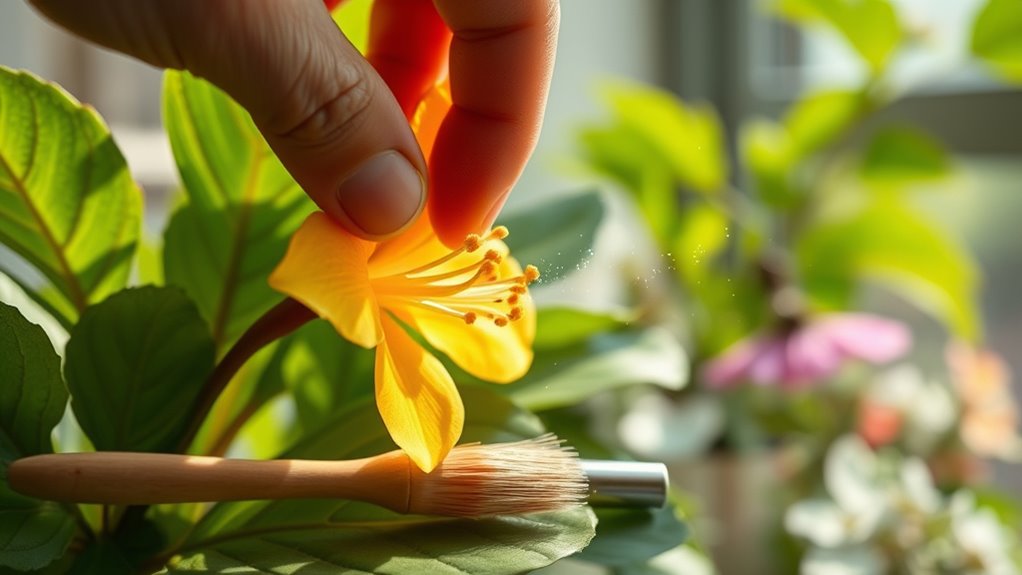
Manual pollination offers numerous advantages that can significantly enhance your indoor gardening experience.
First, it can dramatically improve your crop yield, especially when natural pollinators are scarce. You gain control over which plants are pollinated, ensuring that desired traits are passed on and seed quality is heightened. This method reduces your reliance on nature and guarantees that flowers get the pollination they need for better fruit formation. Additionally, it is particularly beneficial for plants in sheltered areas where natural pollination may be insufficient due to limited access to pollinators.
Manual pollination boosts crop yields by allowing you to control plant pollination and enhance seed quality.
Moreover, manual pollination allows for flexibility in plant selection and delivers consistent results, making it ideal for indoor conditions.
Tips for Encouraging Successful Fruit Production

To encourage successful fruit production in your indoor plants, focus on key factors that directly impact growth and yield.
Start by selecting the right plants, such as tomatoes or peppers, which require pollination. Maintain optimal temperature between 55°F and 85°F and ensure proper humidity levels; misting can help. Additionally, temperature fluctuations can be detrimental to plant health, so it’s important to keep conditions stable.
Provide ample light, either from sunny spots or grow lights, to support healthy growth. Use fans to improve air circulation and mimic natural pollination.
Hand pollinate by transferring pollen with small brushes or shaking the plants gently. Fertilize regularly with nitrogen-rich options and prune to encourage bushier growth.
Lastly, monitor watering practices closely to avoid overwatering, which can lead to root rot.
Frequently Asked Questions
Can I Pollinate Plants During Different Seasons?
Yes, you can pollinate plants during different seasons, but you’ll need to adapt your methods.
In winter, consider using fans to mimic wind, while in summer, opening windows can let in natural pollinators.
Pay attention to your plants’ light and humidity needs, as some are sensitive to excess sunlight.
Adjust your pollination frequency based on their growth cycles, ensuring you’re consistent for the best results.
This approach helps maximize your plants’ health and productivity.
What Are Signs of Successful Pollination?
You’ll know successful pollination has occurred when flowers start to wither or drop their petals.
Look for small fruit forming at the base of the bloom, and notice if the flowers appear slightly swollen. If you see these signs, your efforts paid off.
However, if no fruit develops, that might indicate unsuccessful pollination.
How Does Humidity Affect Indoor Pollination?
Humidity plays a crucial role in indoor pollination. It directly impacts pollen viability; too much or too little can either burst or dry out the pollen.
Optimal humidity levels help maintain the necessary moisture for effective pollination. Additionally, higher humidity can attract pollinators, as they’re drawn to flowers signaling nectar presence.
To enhance indoor pollination success, you should monitor and adjust humidity levels to meet the specific needs of your plants.
Do All Flowers Need Pollination for Fruiting?
You might think all flowers need pollination for fruiting, but that’s not the case. Some flowers, like certain citrus varieties, can produce fruit without it through a process called parthenocarpy. This fascinating ability means they don’t need pollen to develop fruit.
However, most plants require pollination for successful fruiting, which ensures fertilization and seed formation. So, while some can go solo, many still rely on that vital pollen transfer to thrive.
Can I Use Household Items for Pollination?
Absolutely, you can use household items for pollination! A small paintbrush or cotton swab makes a great tool for transferring pollen between flowers.
Even a clean makeup brush can work! Just ensure whatever you use is clean to avoid contamination.
You can also gently shake the plants or use a fan to mimic natural wind, helping distribute pollen effectively.
With a little creativity, you’ll encourage your plants to thrive!
Conclusion
By taking the time to pollinate your indoor plants, you’re not just boosting their growth; you’re unlocking a world of vibrant blooms and delicious fruits that’ll make your home feel like a botanical paradise! Remember, with the right methods and tools, you can easily ensure your plants thrive. So, don’t hesitate—get busy with those pollination techniques and watch your indoor garden transform into a lush oasis that’ll leave everyone in awe!

